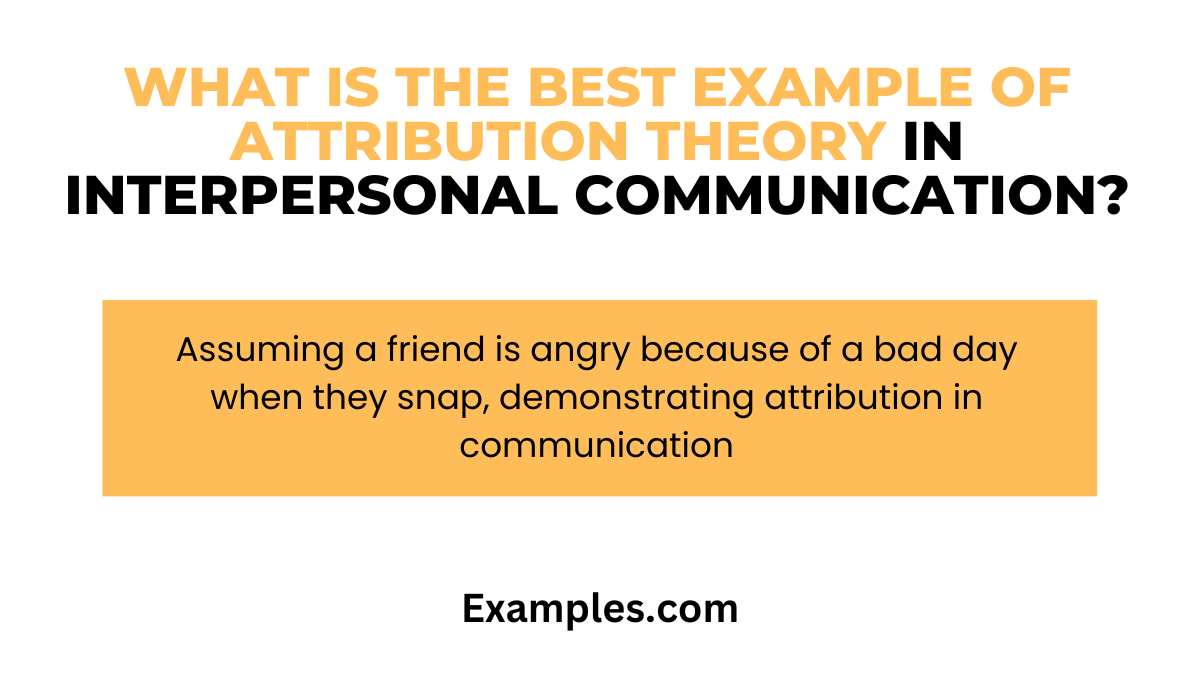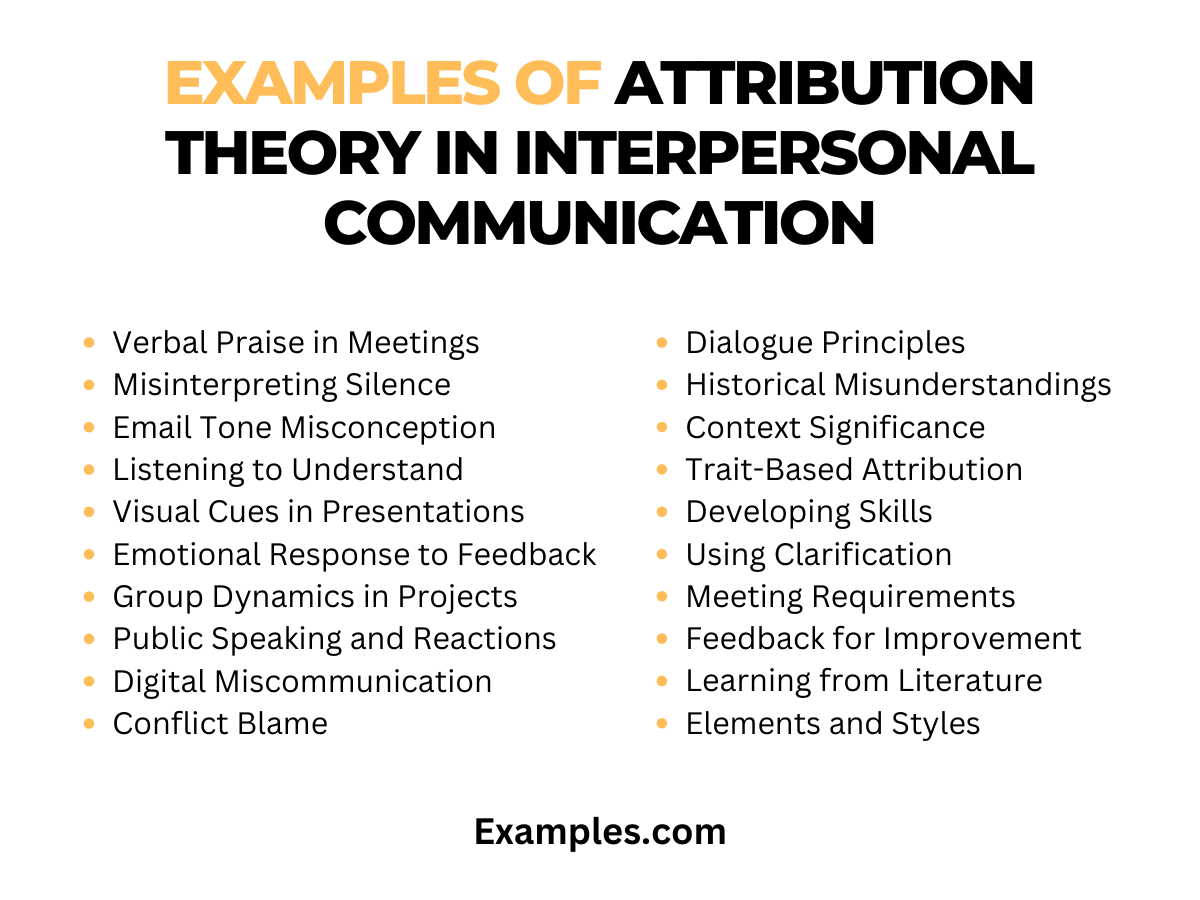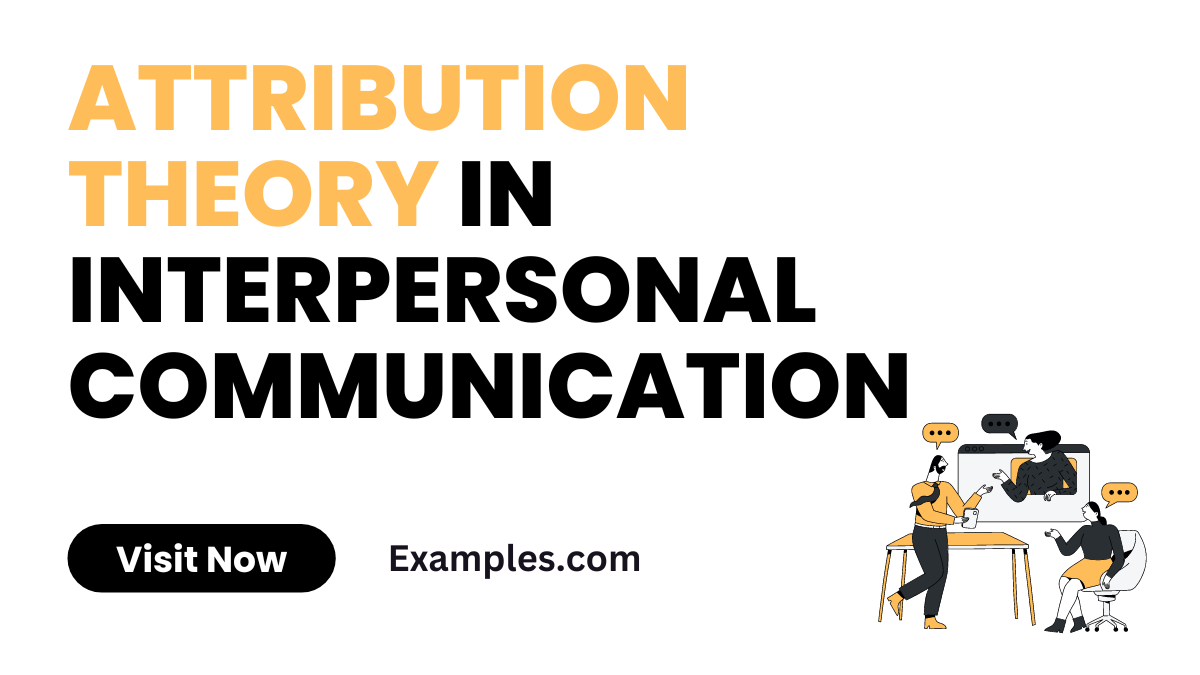19+ Attribution Theory in Interpersonal Communication Examples
Attribution Theory in Interpersonal Communication offers a fascinating window into understanding how we perceive and interpret others’ behaviors. This comprehensive guide delves into the intricate processes behind attribution, elucidating how our judgments and assumptions shape our interactions. By exploring varied examples, readers gain invaluable insights into the dynamic world of interpersonal relationships, enhancing their communication skills and deepening their understanding of this pivotal theory.
What is Attribution Theory in Interpersonal Communication?

Attribution Theory in Interpersonal Communication is a psychological framework that explains how individuals infer the causes of others’ behavior. This theory posits that we attribute behaviors to either internal dispositions or external situations. Understanding this theory is crucial in Interpersonal Communication, as it influences how we perceive and interact with others, shaping our relationships and communication dynamics.
History
Who Created: Fritz Heider
Date: 1950s
It has since become a cornerstone in the study of Interpersonal Communication, offering deep insights into how perceptions and judgments are formed in social interactions. This historical perspective provides a comprehensive understanding of the theory’s evolution and its enduring relevance in communication studies.
What is the Best Example of Attribution Theory in Interpersonal Communication?

A prime example of Attribution Theory in Interpersonal Communication can be seen when a colleague misses a deadline. Instead of immediately assuming laziness (an internal attribution), consider external factors like family issues or workload. This shift in perspective fosters empathy and effective communication, highlighting the theory’s significance in understanding and navigating interpersonal relationships.
20 Examples of Attribution Theory in Interpersonal Communication

Exploring the Attribution Theory in Interpersonal Communication reveals how individuals interpret and explain behaviors in social interactions. This theory is pivotal in understanding how people assign causes to behaviors in personal and professional settings, impacting relationships, conflict resolution, and perception. Delving into varied examples of this theory highlights its significance in everyday communication.
- Verbal Acknowledgment in a Team Meeting: A manager praises a team member’s idea, attributing it to their creativity. This shows positive attribution, enhancing team morale.
- Misinterpretation of Silence: In a conversation, silence is mistakenly attributed to disinterest rather than contemplation. This example illustrates the need for accurate attribution in non-verbal communication.
- Email Tone Misconception: An email’s formal tone is wrongly attributed to anger, leading to unnecessary conflict. It emphasizes the role of clear written communication in avoiding misattributions.
- Effective Listening During a Dispute: Actively listening and then attributing a colleague’s frustration to work stress rather than personal dislike. This highlights the importance of context in attribution.
- Visual Cues in a Presentation: Interpreting a presenter’s confidence through their body language, attributing it to their expertise. Visual communication plays a key role in forming attributions.
- Emotional Response to Feedback: Taking critical feedback personally, attributing it to dislike rather than constructive criticism. Emotional expression can cloud judgment in attribution.
- Group Dynamics in Decision-Making: Attributing the success of a project to collective effort rather than individual contributions. Small group communication often involves collective attribution.
- Public Speaking and Audience Reaction: A speaker attributes audience engagement to their speaking skills, not considering the topic’s relevance. Understanding public communication nuances is crucial.
- Digital Miscommunication: Interpreting a text message’s brevity as rudeness, ignoring technological constraints. Digital communication requires careful attribution to avoid misunderstandings.
- Conflict Resolution Tactics: Blaming interpersonal conflict on personality clashes rather than situational factors. Identifying the correct cause is vital in conflict communication.
- Principles of Effective Dialogue: Recognizing that open communication fosters better understanding and less misattribution in relationships.
- Historical Misunderstandings: Learning from past interactions how misattribution led to conflicts, improving future communication strategies.
- Recognizing the Importance of Context: Understanding that the context significantly influences how we attribute motives in communication.
- Identifying Characteristics: Noticing how certain traits like openness affect our tendency to attribute positively or negatively in interactions.
- Developing Communication Skills: Learning to question our initial attributions leads to more effective interpersonal exchanges.
- Utilizing Communication Tools: Implementing strategies like clarification questions to ensure accurate attribution in conversations.
- Meeting Communication Requirements: Recognizing the necessity of clear, empathetic communication to avoid misattribution.
- Improving through Feedback: Using feedback to refine how we interpret and attribute meanings in interpersonal communication.
- Learning from Books: Gaining insights from literature on how attribution theory plays a role in various communication contexts.
- Understanding Elements and Styles: Recognizing different elements and styles of communication can influence our attribution processes.
Elements of Attribution Theory in Interpersonal Communication
Attribution Theory is a cornerstone in understanding interpersonal communication. It delves into how individuals interpret events and how this relates to their thinking and behavior. Here, we explore eight key elements of Attribution Theory in the context of interpersonal communication.
- Causal Attribution: Central to Attribution Theory, this involves determining the cause of others’ behavior. In interpersonal communication, this means attributing a person’s actions either to their personality (internal attribution) or to the situation they are in (external attribution).
- Internal vs. External Attribution: This dichotomy is crucial in interpersonal communication. Internal attribution assigns behavior to personal traits, while external attribution links it to environmental factors. Understanding this helps in correctly interpreting others’ actions.
- Stability Dimension: This refers to whether an individual perceives the cause of behavior as stable (permanent) or unstable (temporary). In interpersonal communication, this affects how one predicts future behavior in similar situations.
- Controllability: This aspect considers whether the behavior was under the person’s control. In interpersonal communication, perceiving behavior as controllable or uncontrollable influences responses and interactions.
- Fundamental Attribution Error: Often in interpersonal communication, there’s a tendency to overemphasize personal character and underestimate environmental factors when evaluating others’ behavior.
- Self-Serving Bias: This bias leads individuals to attribute their successes to internal factors and failures to external factors. Recognizing this in interpersonal communication can foster more empathetic and understanding interactions.
- Actor-Observer Bias: In interpersonal communication, there’s a tendency for individuals (actors) to attribute their own actions to external factors, while observers attribute the same actions to the actors’ internal characteristics.
- Cultural Influence: Cultural background significantly affects attribution. Individualistic cultures tend to favor internal attributions, while collectivist cultures lean towards external attributions. Understanding this can enhance cross-cultural interpersonal communication.
What Does the Attribution Theory in Interpersonal Communication Suggest About People?
- Causal Attribution: This aspect suggests that people constantly assess the causes of others’ behavior. When someone reacts in a particular way, individuals instinctively try to determine why they behaved as they did. This could be attributed to internal dispositions (character or personality) or external situations (circumstances or environment).
- Error and Bias in Attribution: Often, people make errors or show bias in these attributions. A common error is the fundamental attribution error, where there is a tendency to underestimate situational influences and overestimate dispositional influences on others’ behavior. This indicates a bias towards attributing someone’s actions to their character rather than external factors.
- Self-Serving Bias: This is a tendency to attribute one’s successes to internal factors while attributing failures to external factors. It serves to protect self-esteem.
- Culture and Attribution: Attribution styles can vary culturally. For instance, individualistic cultures might emphasize personal responsibility, leading to a greater focus on dispositional factors. In contrast, collectivist cultures might emphasize situational factors more.
Attribution Theory in Interpersonal Communication offers profound insights into how we perceive and react to others’ behaviors. By understanding key elements like causal attribution, internal vs. external attribution, and various biases, we can enhance our Interpersonal Communication Skills and navigate the complexities of human interaction more effectively. Whether it’s in personal relationships or professional settings, mastering these concepts is essential for effective Interpersonal Communication.



